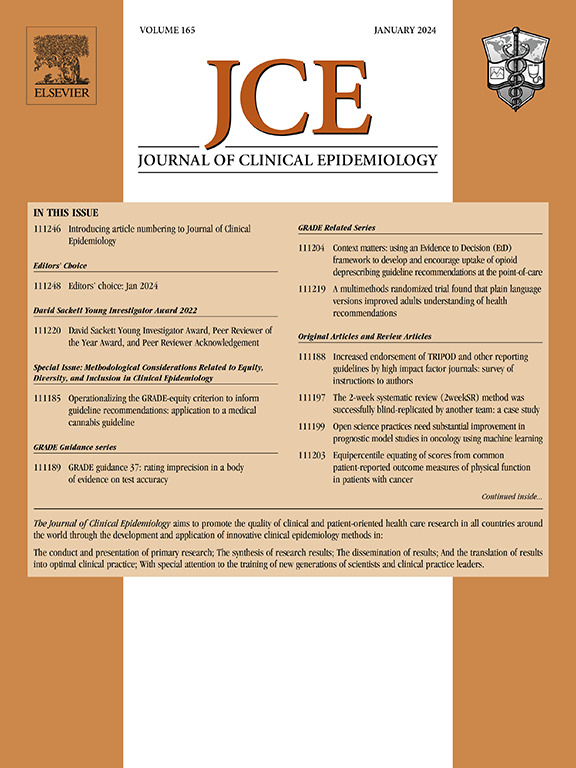Sample size and geographical region predict effect heterogeneity in psychotherapy research for depression: a meta-epidemiological study
IF 7.3
2区 医学
Q1 HEALTH CARE SCIENCES & SERVICES
引用次数: 0
Abstract
Objectives
Depression is a very prevalent and burdensome disease, for which the efficacy of psychological treatments has been extensively studied in randomized controlled trials (RCTs). Meta-analytic evidence in this field is often heavily limited due to heterogeneity, meaning a broad dispersion of true treatment effects and high uncertainty when predicting future outcomes. Causes for this heterogeneity are largely unclear, and cannot be directly examined using conventional meta-analytic methods. Using newly introduced location-scale models, this study is the first to examine direct predictors of between-study heterogeneity in depression psychotherapy trials.
Study Design and Setting
We used a large meta-analytic database containing RCTs on the efficacy of depression psychotherapy. We included studies in all age groups, comparing psychotherapy to control conditions. Risk of bias (RoB) was assessed with the “Cochrane Collaboration Risk of Bias Tool” (Version 1). Univariate analyses were used to explore associations of study-level variables with treatment effect heterogeneity, and multimodel selection to investigate the predictive effect of all variables simultaneously.
Results
We included 539 RCTs with 607 comparisons, with 35% showing low overall RoB. Higher heterogeneity was found in studies with high RoB and lower sample sizes; heterogeneity varied depending on the geographical region where trials were conducted. Based on multimodel selection, the most important predictors of effect heterogeneity were geographical region, baseline sample size, and RoB. These predictors were also significant after model averaging.
Conclusion
Our study shows that several study-level variables predict the heterogeneity of treatment effects in psychotherapy research, and thus their predictability across different contexts. To enhance the robustness of pooled effects, meta-analysts may consider restricting their synthesis to methodologically rigorous studies only. Our findings also indicate that the assumption of constant heterogeneity in “traditional” random-effects analyses might often be violated, making sensitivity analyses imperative.

样本大小和地理区域预测抑郁症心理治疗研究的效果异质性:一项荟萃流行病学研究。
目的:抑郁症是一种非常普遍和繁重的疾病,心理治疗的效果已经在随机对照试验(RCTs)中进行了广泛的研究。由于异质性,该领域的荟萃分析证据往往受到严重限制,这意味着真实治疗效果的广泛分散和预测未来结果时的高度不确定性。造成这种异质性的原因在很大程度上是不清楚的,不能直接使用传统的元分析方法进行检查。使用新引入的位置尺度模型,本研究首次检验了抑郁症心理治疗试验中研究间异质性的直接预测因子。研究设计和背景:我们使用了一个大型荟萃分析数据库,其中包含关于抑郁症心理治疗疗效的随机对照试验。我们纳入了所有年龄组的研究,将心理治疗与对照条件进行比较。采用Cochrane Collaboration Risk of bias Tool (Version 1)评估偏倚风险(RoB)。采用单因素分析探讨研究水平变量与治疗效果异质性的关系,并采用多模型选择同时研究所有变量的预测效果。结果:我们纳入了539项随机对照试验,共607项比较,其中35%显示总体RoB较低。在高RoB和低样本量的研究中发现较高的异质性;异质性因进行试验的地理区域而异。基于多模型选择,最重要的效应异质性预测因子是地理区域、基线样本量和RoB。这些预测因子在模型平均后也具有显著性。结论:我们的研究表明,几个研究水平的变量预测了心理治疗研究中治疗效果的异质性,因此它们在不同背景下的可预测性。为了增强合并效应的稳健性,元分析者可能会考虑将他们的综合限制在方法学上严格的研究中。我们的研究结果还表明,“传统”随机效应分析中恒定异质性的假设可能经常被违反,这使得敏感性分析势在必行。
本文章由计算机程序翻译,如有差异,请以英文原文为准。
求助全文
约1分钟内获得全文
求助全文
来源期刊

Journal of Clinical Epidemiology
医学-公共卫生、环境卫生与职业卫生
CiteScore
12.00
自引率
6.90%
发文量
320
审稿时长
44 days
期刊介绍:
The Journal of Clinical Epidemiology strives to enhance the quality of clinical and patient-oriented healthcare research by advancing and applying innovative methods in conducting, presenting, synthesizing, disseminating, and translating research results into optimal clinical practice. Special emphasis is placed on training new generations of scientists and clinical practice leaders.
 求助内容:
求助内容: 应助结果提醒方式:
应助结果提醒方式:


